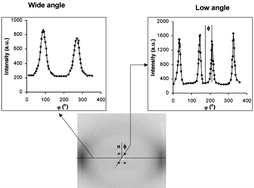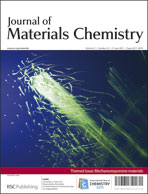The synthesis of a new series of polysiloxane-based, main-chain liquid crystal elastomers (MC-LCEs) containing unsymmetric mesogenic units is described. The structure of the mesogenic monomers, spacers and cross-linkers has been varied systematically in order to tune the thermotropic behaviour of the networks. Three unsymmetric mesogens were studied, characterised by having two aromatic rings as the rigid core and two different alkoxy chains. Smectic A or nematic phases were observed, depending on the length of the alkoxy chains. These mesogens were combined with three different spacers, a flexible hexamethyltrisiloxane (S1) and two aromatic bis(dimethylsilyloxy)benzene with the silyl groups disposed para (S2) or meta (S3). To form the MC-LCEs, two cross-linkers were chosen, one flexible 2,4,6,8-tetramethylcyclooctasiloxane (C1) and a rigid, aromatic tris(dimethylsilyl)benzene (C2). The elastomers showed low glass transition temperatures (below 0 °C) and low clearing temperatures (between 30 and 72 °C), as such presenting liquid crystalline properties at room temperature. The transition temperatures could be tuned by a simple choice of the components; for instance, the clearing temperature decreased as aromatic spacers or cross-linkers were introduced. In contrast, the glass transition temperature did not depend on the cross-linker or mesogen used and showed only a small dependence on the structure of the spacer. The phase behaviour of the MC-LCEs was affected greatly by the spacer used and networks containing the trisiloxane spacer systematically exhibited the smectic C phase. The insertion of aromatic spacers favoured the formation of a nematic phase over a smectic phase when the flexible cross-linker, C1, was used. This behaviour was enhanced by the addition of the aromatic cross-linker C3, so that the smectic C phase was suppressed totally and only a nematic phase was observed. The synthesis of the components of MC-LCEs is presented and the structure–thermal properties relationships of the MC-LCEs are discussed.


 Please wait while we load your content...
Please wait while we load your content...